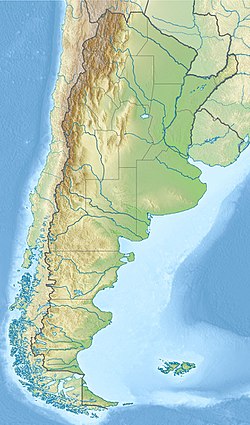위트레라층
Huitrera Formation| 위트레라층 | |
|---|---|
| 층서 범위:초기 에오세(카사마요란) | |
| 유형 | 지질 형성 |
| 언더라이즈 | 콜론 퀴라 포메이션 |
| 오버라이즈 | 앙고스투라 콜로라다층 |
| 두께 | 최대 1,300 m(4,300 피트) |
| 암석학 | |
| 기본적인 | 머드스톤, 사암 |
| 다른. | 안데스석, 타카이트 및 유문 이그님브라이트, 화산벽암, 응회암 및 트라키바살트 |
| 위치 | |
| 좌표 | 41°00ºS 71°12°W/41.0°S 71.2°W좌표: 41°00µS 71°12ºW / 41.0°S 71.W / 2 |
| 근사고좌표 | 43°30ºS 61°12°W/43.5°S 61.2°W |
| 지역 | 네우켄 & 리오 니그로 주 |
| 나라 | 아르헨티나 |
| 정도 | 노이켄 분지 |
| 유형 섹션 | |
| 이름: | 케로 위트레라 |
| 이름 지정자 | 라바졸리 & 세사나 |
| 정의된 연도 | 1977 |
위트레라 층은 아르헨티나 파타고니아 북부 네우켄 분지에 있는 지질층이며, 지층은 고생대 초기 에오세(남미 육지 포유류 연령 분류로는 카사마요란)로 거슬러 올라간다.
묘사
위트레라 층은 1977년 라바졸리와 세사나에 의해 처음 정의되었다.이 이름은 다양한 화산 폭발 순서를 식별하기 위해 사용되었으며, 특히 니리후우 접힘-추스트 [1]벨트에서 사용되었다.최대 1,300m(4,300ft) 두께의 층은 분화구 호수 환경에 퇴적된 토석과 사암으로 구성됩니다.생성물의 일부는 안데스암, 타카이트 및 유문 이그님브라이트, 화산벽암, 응회암 및 트라키바살트로 [2]구성된다.
이 생성은 처음에는 E신세 말기부터 올리고세 초까지로 설명되었지만, 나중에 54.24 ± 0.45Ma로 추정되었다. 즉, Huitrera 생성은 Ypresian 또는 SALMA 분류에서 나이로는 Casamayoran이다.
화석 내용물
다음과 같은 매크로 화석이 [3]생성되었다.
또한 2003년 멜렌디 등이 분석한 [11]꽃가루가 많이 생성되었다.
「 」를 참조해 주세요.
- 남미 육지 포유류 시대
- 라구나 델 훈코층, 카냐돈 아스팔토 분지의 동시대의 화석층
- 브라질 이타보라이 분지의 화석층인 이타보라이층
- 콜롬비아 중부의 동시대 화석인 보고타층
- 미국 중서부의 동시대의 화석층인 그린 리버층
- 클론다이크 산층, 워싱턴주의 동시 화석 식물군
- 독일 에오세 크레이터 호수 라거슈테테의 메셀 피트
레퍼런스
- ^ Escosteguy & Franchi, 2010, 페이지 420
- ^ Presz & Massafero, 2013, 페이지 228
- ^ Huitrera Formation (Fossilworks.org )
- ^ Degrange, F. J.; Pol, D.; Puerta, P.; Wilf, P. (2021). "Unexpected larger distribution of Paleogene stem-rollers (Aves, Coracii): new evidence from the Eocene of Patagonia, Argentina". Scientific Reports. 11 (1): Article number 1363. doi:10.1038/s41598-020-80479-8. PMC 7809110. PMID 33446824.
- ^ Baez & Pugner, 2003
- ^ 아란시아가 외, 2019년
- ^ Jin et al., 2020
- ^ 라미레스 외, 2016년
- ^ Jud et al., 2018
- ^ Barrera 등, 2012년
- ^ Melendi et al., 2003
참고 문헌
- ; ; ; ; , and . 2020. A comprehensive phylogeny of flat bark beetles (Coleoptera: Cucujidae) with a revised classification and a new South American genus. Systematic Entomology 45. 248–268. doi: 10.1111/syen.1292
- ; , and . 2019. A new pipoid frog (Anura, Pipimorpha) from the Paleogene of Patagonia. Paleobiogeographical implications. Comptes Rendus Palevol 18. 725–734. doi: 10.1016/j.crpv.2019.04.003
- ; ; , and . 2018. Fossil moonseeds from the Paleogene of West Gondwana (Patagonia, Argentina). American Journal of Botany 105. 927–942. doi: 10.1002/ajb2.1092 PMID 29882954
- ; , and . 2016. First fossil record of parasitic flat-bark beetle (Coleoptera: Passandridae) from the Eocene of Patagonia, Argentina. Ameghiniana 53. 160–169. doi: 10.5710/AMGH.29.11.2015.2920
- , and . 2013. Geología y geomorfología del tramo superior del Arroyo Comallo, Río Negro. Contribuciones Científicas GÆA 26. 221–234. Accessed 2020-06-13.
- ; ; ; ; ; ; ; , and . 2012. An extinct Eocene taxon of the daisy family (Asteraceae): evolutionary, ecological and biogeographical implications. Annals of Botany 109. 127-134.
- , and . 2010. Estratigrafía de la región de Chapelco, Provincia del Neuquén. Revista de la Asociación Geológica Argentina 66. 418–429. Accessed 2020-06-13.
- , and . 2003. Ontogeny of a new Palaeogene pipid frog from southern South America and xenopodinomorph evolution. Zoological Journal of the Linnean Society 139. 439–476. doi: 10.1046/j.1096-3642.2003.00085.x
- ; , and . 2003. Palynostratigraphy of the Paleogene Huitrera Formation in N-W Patagonia, Argentina. Neues Jahrbuch für Geologie und Paläontologie, Abhandlungen 228. 205-273.



